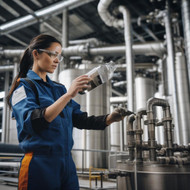Advancing Chemistry for a Cleaner, Greener Future: How Surfactants and Glycol Ethers Shape Eco-Friendly Cleaning
Posted by MH on Sep 5th 2025
Advancing Chemistry for a Cleaner, Greener Future: How Surfactants and Glycol Ethers Shape Eco-Friendly Cleaning
New Age of Cleaning Chemistry
Advances in surfactant chemistry and glycol ether technology are redefining what’s possible in cleaning and degreasing—across homes, businesses, and industry. These innovations deliver better performance, greater safety, and reduced environmental impact. The result is a new generation of biodegradable cleaners and eco-friendly degreasers that perform exceptionally while supporting sustainability goals.
For buyers and EHS teams seeking options, visit our catalog of chemicals & ingredients and cleaning & sanitation solutions.
Why Traditional Formulations Fell Short
- Environmental impact: Legacy surfactants and solvents could persist in waterways or contribute to nutrient loading and smog.
- Inefficiency: Higher use levels were common to achieve acceptable results, increasing waste and cost.
- Human factors: Harsh solvents raised worker-safety concerns (skin/eye/respiratory irritation) and complicated compliance.
Breakthrough #1: Better Cleaning Performance
Modern surfactants and glycol ethers are engineered to target oily soils, carbonized residues, and complex films with higher efficiency. This translates to lower in-use concentrations, less mechanical action, and reduced water and energy demand. For example, nonionic systems built on linear alcohol ethoxylates (LAEs) deliver excellent grease cutting, while newer propylene-series glycol ethers provide strong solvency with more favorable safety profiles.
Breakthrough #2: Biodegradability & Environmental Safety
Today’s best-in-class formulations emphasize ready biodegradability—meaning they efficiently break down during biological wastewater treatment, mitigating persistence and ecotoxicity. Carefully selected surfactants and solvents are designed to degrade into benign components (CO2, water, and salts), easing the load on municipal treatment plants and protecting aquatic ecosystems.
Surfactant Chemistry: The Workhorse of Cleaning
Surfactants lower water’s surface and interfacial tension, enabling wetting, soil lift, and micelle formation. Modern systems combine multiple classes to broaden performance across temperature, pH, and water hardness.
Advanced Surfactant Examples
- Linear Alcohol Ethoxylates (LAEs): Nonionic, strong on oily soils, and readily biodegradable; widely used in hard-surface degreasers.
- Alkyl Polyglucosides (APGs): APGs are Plant-derived (e.g., corn/coconut). Mild, effective, and favored for eco-friendly cleaners and food-contact surfaces.
- Amphoteric Surfactants (e.g., betaines): Broad pH tolerance, foam boosting, and good dermatological profiles; commonly paired with nonionics.
- Milder SLS alternatives: Newer anionics/zwitterionics maintain foam and detergency with improved environmental and skin-mildness profiles.
See our Sodium Lauryl Sulfate (SLS) powder page for typical specs and positioning alongside milder alternatives in certain applications.
Glycol Ether Innovations: Precision & Safety
Glycol ethers act as powerful co-solvents to dissolve oils, inks, and resins. Newer propylene-series options emphasize lower volatility and better toxicological profiles than older ethylene-series solvents, helping reduce VOCs and worker exposure.
Eco-Forward Glycol Ether Examples
- Propylene Glycol n-Butyl Ether (PnB): Excellent grease solvency; lower vapor pressure vs. legacy options aids indoor-air goals.
- Dipropylene Glycol Methyl Ether (DPM): Versatile in coatings/inks and heavy-duty cleaners; balanced solvency and handling.
- Propylene Glycol Methyl Ether Acetate (PMA): Powerful solvency for films and polymers; widely used where controlled evaporation is beneficial.
Real-World Applications
1) Industrial Degreasing
Blends of nonionic surfactants (e.g., LAEs/APGs) with PnB or DPM tackle machining oils and soils effectively—often at lower temperatures—helping reduce energy consumption and cycle time.
2) Household & Food-Service Cleaning
APG-rich formulas paired with milder co-solvents deliver high performance on hard surfaces and cookware while maintaining food-contact safety requirements and biodegradability.
3) Automotive & Metal Prep
PnB-based systems remove greasy residues prior to painting or coating, supporting finish quality and compliance with evolving VOC rules.
The Environmental Payoff
- Reduced water pollution: Readily biodegradable actives minimize aquatic persistence.
- Improved worker safety: Lower volatility and milder toxicology support safer handling.
- Lower carbon & resource use: Efficient soil removal can reduce water, heat, and agitation needs.
- Simpler compliance: Alignment with programs like EPA Safer Choice can streamline procurement and EHS reviews.
What’s Next in Green Chemistry
- Enzyme-surfactant synergy: Enzymes targeted to specific soils enable lower temperatures and shorter wash times.
- Bio-based solvents: Emerging glycol-ether analogs from renewable feedstocks promise further VOC and toxicity gains.
- “Smart” systems: Formulations tuned for hardness, temperature, and pH to maintain peak performance in real-world conditions.
Conclusion: Cleaning Without Compromise
Advances in surfactants and glycol ethers prove that modern chemistry can deliver products that are powerful, safe, and sustainable. By adopting biodegradable cleaners and eco-friendly degreasers, organizations can meet performance targets and environmental commitments—without compromise.
Level 7 Chemical offers many new advanced surfactants and glycol ethers
Propylene Glycol n-Butyl Ether (PnB)
References
- U.S. Environmental Protection Agency – Safer Choice Program
- OECD – Guidelines for Testing of Chemicals: Biodegradability
- American Cleaning Institute – Surfactants & Solvents in Cleaning
- European Chemicals Agency (ECHA) – REACH Regulation

